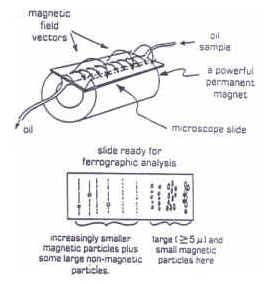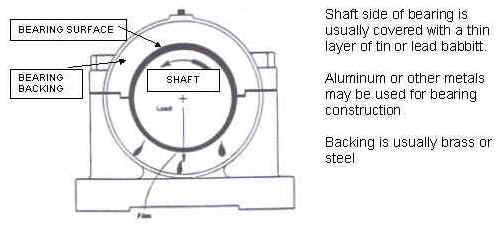
Bearings
Journal bearings
Roller bearings
Journal bearings

Roller bearings
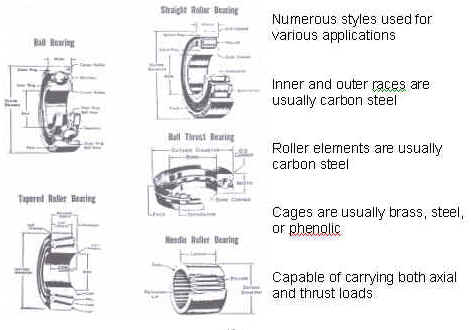
Gears
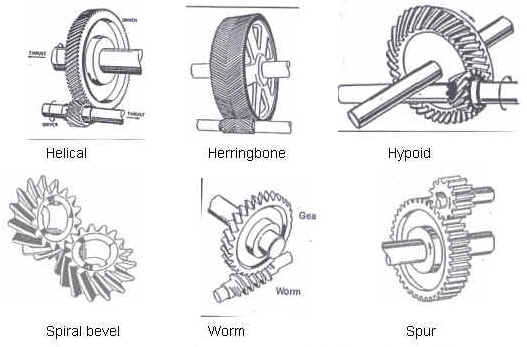
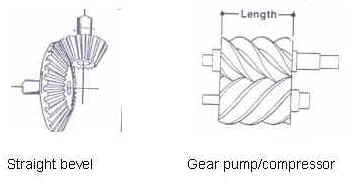
Sliding and Reciprocating Components
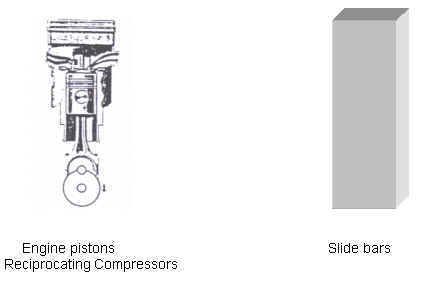
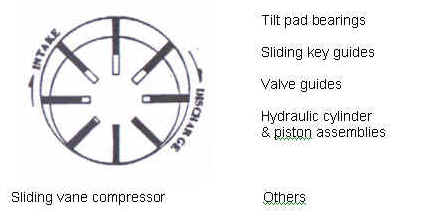
Analysis Programs
A complete lube oil analysis program should provide you with three pieces of information:
Condition of the oil wetted components of the machine and their wear rates;
Condition of the lubricant and whether it can continue to be used or has to be replaced or reconditioned;
Level of contamination and what the contamination is.
Basic Tests
Paper Chromatography
Centrifuge
Spectrographic Metals analysis
Viscosity
Neutralization Number (TAN and/or TBN)
Fourier Transform Infrared Analysis (FTIR)
Flash Point
Karl Fischer Water Titration
Particle Count/Distribution
Direct Read Ferrography
Wear Particle Analysis
Others as required
Paper Chromatography
Probably the first test that should be done to every sample that is processed in a lab.
Good qualitative test for the presence of water, fuel, coolant, excessive solids, and the oil’s dispersency
This test also forces the technician to visually inspect the sample for large particulates and odd coloration, as well as note any odd odors.
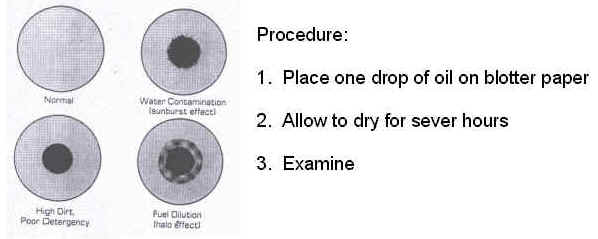
Centrifuge
Quantifies water >.1% and sediment > 0.06%
Test is usually not done unless blotter or other test indicates need.
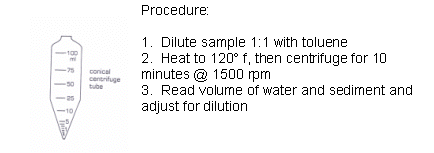
Spectrographic Metals analysis
Usually performed on rotating disk emission spectrometer or inductively coupled plasma spectrometer. Both use atomic emission principle.
Instruments can analyze for 20 – 25 metals simultaneously. Results are usually reported in parts per million (ppm)
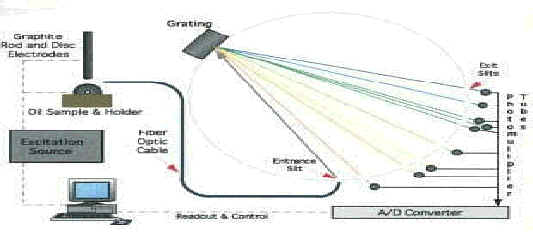
Rotating Disk Atomic Emission Spectrometer
Instrument is quick, accurate, and inexpensive to operate
Particle size limitation is about 10 µ, depending on metal and level of surface oxidation on particle surface.
Accurate to about 1 or 2 ppm
No dilution of sample is required
Results include wear, additive, and contaminant metals
Inductively Coupled Plasma Spectrometer
Instrument is very accurate,
Particle size limitation is 1-3 µ
Sample dilution is required
More expensive to operate as argon and nitrogen gases are required.
Typical spectrographic metals reported
|
Wear |
Additive |
Contaminant |
|
Iron |
Silicon |
Silicon |
|
Lead |
Boron |
Boron |
|
Copper |
Copper |
Sodium |
|
Tin |
Sodium |
Phosphorus |
|
Aluminum |
Phosphorus |
Potassium |
|
Chromium |
Zinc |
Calcium |
|
Nickel |
Calcium |
Magnesium |
|
Silver |
Magnesium |
|
|
Titanium |
Molybdenum |
|
|
Zinc |
Antimony |
|
Viscosity
Key property of a lubricant
Many things affect an oil viscosity
Product or fuel dilution
Polymerization caused by degradation
Water and glycol
Dirt and wear metals
Usually run at standard temperatures: 40°c for most oils and 100°c for engine oils. Results are reported in centiSstokes (cSt) for these temperatures. Test can also be run at 100°f and 210°f respectively and reported in Saybolt Universal Seconds (SUS)
Tests are accurate and easily trended
Inexpensive to run
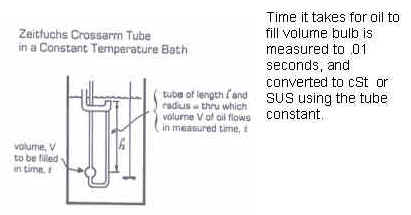
Neutralization Number (TAN and/or TBN)
Total Acid Number (TAN)
Titration of the acids that build up in lubricant due to degradation and contamination.
Reported as mg KOH/gm sample, or simply how many milligrams of potassium hydroxide did it take to neutralize the total amount of acid in one gram of sample.
Test can be varied to report strong and weak acids.
Test can be run with a color indicator or potentiometrically (using a pH sensor)
Total base number (TBN)
Titration of the alkaline, caustic, or basic constituents in the oil due to corrosion inhibitor additives or contaminants
Reported as mg HCl/gm sample, or how much hydrochloric acid did it take to neutralize the basic constituents in one gram of sample.
Test is usually run potentiometrically, but can be run with color indicator.
TBN titrations are appropriate for engine oil analysis
Both tests report on the condition of the oil
Fourier Transform Infrared Analysis (FTIR)
Measures a number of different chemical bonds by absorbing infrared light. Different chemical bonds will react at different wavelengths
Water Glycol Oxidation products
Fuel Nitration Sulfur-oxygen
Instrument passes an infrared light through or reflected off of a sample in a sweeping range of wavelengths from 600 to 4000 nanometers. A detector measures the amount of absorption at each preset increment, usually 2 nanometers
Unless a calibration curve is developed for each lubricant and each constituent, FTIR analysis is more qualitative than quantitative. Constituents such as soot, fuel, oxidation, nitration are often reported in indexes, rather than parts per million for example
Instrument can be used in % transmission or absorbence mode.
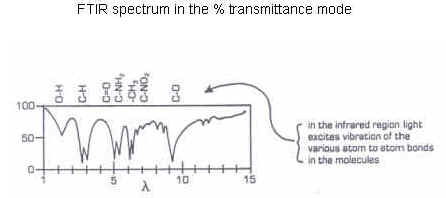
Karl Fischer Water Titration
Quantitative titration for measurement of water
Measures free, dissolved, and emulsified water
Accurate down to 10 ppm
Most often performed with automatic titrators
Only acceptable method for measuring quantities below 500 ppm
Subject
to some interference:
Free alkali
Some sulfur compounds
Some nitrous compounds
Can be used for trending purposes when strong interference is present.
With sample pre-treatment, can measure moisture in solids and semi-solids
Can measure moisture in gases
Reagents are hazardous and expensive
Particle Count/Distribution
Reported in particles in various size ranges per cc of sample.
The count can be put into an NAS 1638 or ISO 4406 classification
Laser light scattering
A laser light is shined through a flowing stream of lubricant. The reflected, refracted, and transmitted lights resulting from particles passing through the laser light are measured versus time. The number and size of the particle can then be calculated.
Flow curve degradation
A known quantity of sample is flowed through a calibrated screen. The flow curve degradation due to particles building up on the screen is measured versus time. The number and size of particles can then be calculated
Microscopic count
A portion of sample diluted to 100 ml is poured evenly over a 0.45µ gridded filter patch. Particles on a representative number of grids are visually counted and sized.
ISO classification is reported in three ranges.
Ex: 17/13/10 where 17 is the range number of particles > 2µ, 13 is the range number of particles > 5µ, and 10 is the range number of particles > 15µ.
ISO 4406 range number classification (particles/100 ml)
NAS 1638 range number classification (particles/100 ml)
Direct Read Ferrography

Wear Particle Analysis
